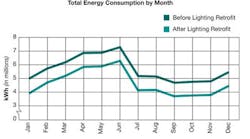In a slow economy, many companies have looked for ways other than cost-cutting to improve their profit margins, including energy-management strategies. Addressing the energy efficiency of a plant or other facility can lead to lower utility costs, but it also may provide unexpected improvements in environmental conditions.
Lukfin Industries is a Texas ferrous foundry that faced rising energy costs, averaging 5-7% of total operating expense, which was on par with the rest of the industry. The foundry — which produces castings used to fabricate components for railroad parts, oilfield equipment, and power transmission supplies — addressed the situation by looking at its energyrelated costs. The goal was not only to reduce consumption; Lufkin’s managers wanted to address energy usage — from individual cost components to total environmental impact.
Enter GDF SUEZ Energy Resources, a non-residential electricity provider to over 73,000 customers, with peak demands ranging from 50 to over 200 kW; and American Energy Solutions (www. americanenergy.com), which develops industrial energy management strategies that integrate greenhouse gas and carbon emission programs. The trio conducted an energy audit, and then benchmarked Lufkin’s usage patterns to address potential opportunities to improve energy efficiency plantwide. This initial assessment identified for Lufkin the areas, systems, and manufacturing processes that could be considered.
The plant’s lighting system was the primary problem, and it offered the greatest potential to save money and reduce the carbon footprint. Addressing its energy consumption offered such significant benefits that Lufkin managers authorized an unbudgeted capital project to move as quickly as possible on the improvements.
The audit concluded that nearly one-third of Lufkin’s total energy consumption was attributable to its lighting system, which included high-wattage, metal-halide and high-pressure sodium (HPS) fixtures for high-bay installations, as well as magnetic, T12 lamps and ballasts for low-bay and office lighting.
A complete lighting retrofit, converting Lufkin to a more efficient system with custom fixtures (four-lamp and six-lamp T5HO for high-bay and T8 fixtures with electronic ballast for low-bay and office lighting) was proposed. Additionally, occupancy controls (turn the lights off when spaces are unoccupied) were recommended throughout the facilities. The retrofit would take place at five of the company’s facilities in and near Lufkin, TX: the corporate office, the foundry, the Buck Creek location in South Lufkin, a gear repair facility, and the power transmission plant. The estimated reduction in energy usage was 11,938,207 kWh — 18% of the company’s annual energy usage.
That estimated decrease would save $800,000 annually and qualified Lufkin for two rebate programs totaling $675,000. The company also received federal tax incentives totaling $100,000 through the Energy Policy Act of 2005. Also, Lufkin reduced its CO2 emissions by 16,958,929 pounds.
Installing the new four-lamp and sixlamp T5HO fixtures in the foundry took eight weeks. Normally, such an installation takes half that time, but installation was scheduled to accommodate production, to eliminate lost-production costs. The new lights in the foundry were an improvement on the previous fixtures, which were not coordinated or controlled, leading to dark areas and the tendency to leave lights constantly.
The total installation across the five facilities was completed on time and on budget, and without disruption to normal operations.












